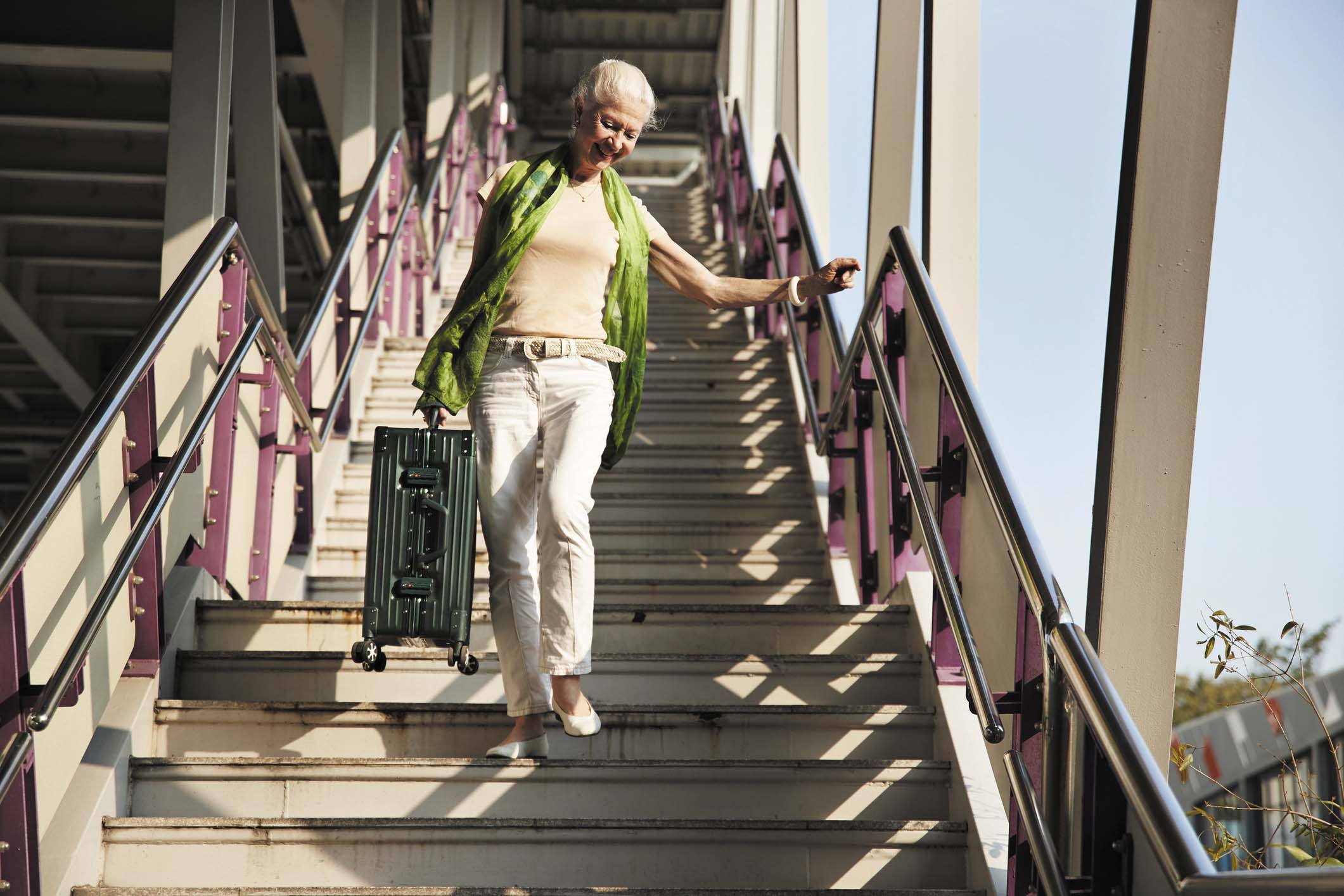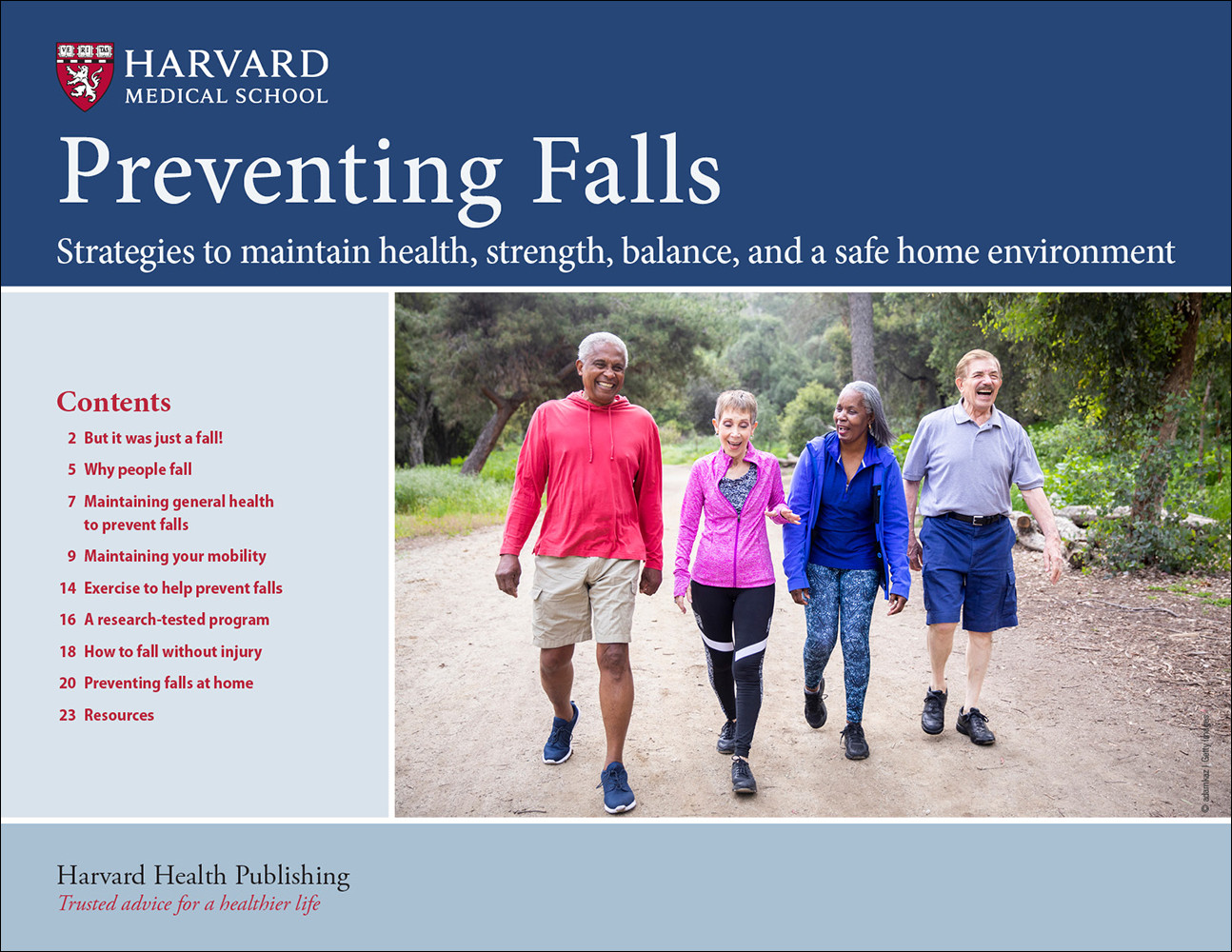Protect yourself from falls outside the home
Here's how to identify and avoid fall hazards in everyday destinations.
- Reviewed by Anthony L. Komaroff, MD, Editor in Chief, Harvard Health Letter; Editorial Advisory Board Member, Harvard Health Publishing

Even if you've fall-proofed your home, the outside world is full of hazards that might lead to dangerous trips and tumbles. And since falls are a major cause of broken bones, head injuries, and injury-related deaths, especially as we get older, it's essential to know how to stay safe once you step outside your door. Here are tips to avoid falls in a variety of public areas.
Stores
Stores often have smooth floors that can be slippery or even wet. When you're going shopping, make sure you're wearing shoes with nonslip treads. If you suspect that you have a balance problem, plan on using something for support during your shopping trip. "That could be a shopping cart that you lean on or a store's electric scooter. Or use a rollator, a type of walker with four wheels, hand brakes, a basket, and a built-in seat. It keeps you stable and gives you a chance to sit down and take a break anywhere," says Barbara Ranucci, a physical therapist at Harvard-affiliated Spaulding Rehabilitation Hospital.
She also advises being extra careful when reaching for items. "If they're above your shoulders, you might lose your balance and fall backward," Ranucci says. "When reaching, stand with one foot forward and one foot back for stability, or just ask for assistance."
Crowded venues
Busy airports, shopping malls, concert halls, or theaters can land you in the middle of crowds, with lots of people who might bump into you, causing a fall. To guard yourself, hold on to a partner as you walk, or use a rollator for stability. "The rollator will also act as a red flag to others to use caution around you and give you space," Ranucci says.
Parks and playgrounds
Are you going for a walk, jog, or hike in a park? Are you taking your grandkids to a playground? Keep an eye out for uneven terrain, which increases your fall risk. Red-flag areas include the spots where two types of terrain meet, such as a parking lot and a mulchy playground. Make sure you wear the proper footwear, such as sneakers with deep (not flat) treads or hiking boots.
Public staircases
If you feel unstable on stairs, it's best to avoid them and take an elevator. If you don't have that option, use extra caution on stairs. They might not be the same depth or width as the stairs you're used to at home. Above all, hold the handrail. Wear glasses if you need them. Go slowly. And if the stairway is dark, keep one hand on the railing and the other on a small portable flashlight (or your smartphone, with a flashlight app) to light the way.
Public bathrooms
Bathrooms are notorious for having wet, slippery floors that cause falls. And public bathrooms often have the added hazards of poor lighting and low toilets.
Go into the bathroom with caution. Ranucci advises that you always have your phone with you, in case you can't get up from a low toilet seat and need to call for assistance.
You might also need your phone's flashlight if the bathroom lighting is low. If possible, use the handicap stall, which has grab bars and a higher toilet.
If you have to cross a wet floor, walk slowly, with your feet pointed slightly outward for more stability.
Parking lots or garages
While it's good exercise to park far from a store and walk a longer distance, avoid doing this if you have endurance issues or joint pain that increases your fall risk. Park closer to your destination, and don't be reluctant to ask your doctor to approve a handicap placard if you need one.
Also: avoid parking too close to another vehicle and assuming you can squeeze between your car and the other. Ranucci says that makes it difficult to exit a vehicle safely, especially if you use an assistive walking device. And if you have to do any turning or sidestepping to move between vehicles, you might increase the risk of losing your footing and falling.
When possible, give yourself plenty of space to get out of your vehicle and move freely. If you have a handicap placard, use the space if it's available.
Office buildings
Office buildings are filled with the same types of hazards found at home, such as stairs, slippery floors, floor clutter, poor lighting, and loose rugs. Plus, they can have escalators, ladders, scaffolding, industrial equipment, and construction areas — which all increase the risk for falls.
Remove what you can from your work space, such as floor clutter and long electrical cords, and report fall hazards to management.
And if you're visiting an office building — say, for an appointment with your doctor — try not to rush as you walk; move deliberately. Scour the environment as if you're conducting an inspection for potential fall hazards, and avoid them.
Consider how the weather affects your fall riskPreparing for the weather before going out is an important part of the plan to maintain balance and avoid a fall. If it's hot and sunny, dehydration can make you feel overheated or woozy, which can cause a fall. Wear a hat, bring a water bottle, stay hydrated, and head for the shade or airconditioned spaces when possible. If it's rainy or icy, the risk of slipping increases. Wear the right gear, including nonslip shoes. "You need supportive shoes that fit well and have good anti-slip treads. We recommend wearing rubber or spiked shoe covers that you pull on over the sole of your sneaker or boot," says Barbara Ranucci, a physical therapist at Harvard-affiliated Spaulding Rehabilitation Hospital. |
A final word
No matter where you go, balance training will help you do a better job of navigating fall hazards.
"Leg and core strength are among the most important components for balance," Ranucci says. "Your vision, inner ear health, and sensitivity in your feet and joints are also essential components of balance." She advises seeking physical therapy if you suspect you have balance issues.
If you're generally healthy, make sure your regular exercise routine includes leg and core strengtheners such as sit-to-stands (standing in front of a chair, sitting down, then standing again, five to 10 times in a row), lunges, and leg lifts. And try balance exercises, such as standing on one leg for 30 seconds at a time or walking across a room as if you're walking on a tightrope.
For more information on balance exercises, check out the Harvard Special Health Report Better Balance.
Image: © Klaus Vedfelt/Getty Images
About the Author

Heidi Godman, Executive Editor, Harvard Health Letter
About the Reviewer

Anthony L. Komaroff, MD, Editor in Chief, Harvard Health Letter; Editorial Advisory Board Member, Harvard Health Publishing
Disclaimer:
As a service to our readers, Harvard Health Publishing provides access to our library of archived content. Please note the date of last review or update on all articles.
No content on this site, regardless of date, should ever be used as a substitute for direct medical advice from your doctor or other qualified clinician.
















